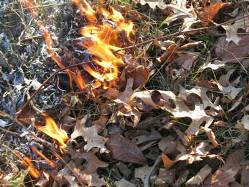
Could cultivating broad-leaved plants really prove a practical precaution against the potential dangers of global warming? Ian Randall* reports.
Geoscientist Online 12 August 2010
An international team of researchers has discovered an increase in fire activity at the Triassic/Jurassic boundary, 200 million years ago. They believe it was caused by a climate-driven increase in lighting strikes, and a matching shift towards more inflammable plants.
By measuring the proportions of fossilised charcoal from eight plant-rich beds in Astartekløft, East Greenland, the team was able to observe a five-fold increase in fire activity from the Late Triassic into the boundary with the Jurassic. This peak coincided with a maximum in atmospheric carbon dioxide levels at the boundary – symptomatic of the increase in global temperatures believed to have been brought on by massive volcanism from the Central Atlantic Magmatic Province.
A change in the nature of the flora of the time, induced by rising temperatures, may have enabled wildfires to spread faster. The vegetation found in the Astartekløft sections shows an increase in narrow-leaved morphologies across the Triassic/Jurassic boundary, coinciding with the peak in fire activity as measured by the charcoal. The researchers believe that narrower leaves, which have a low surface area to volume ratio, burn much better than broader ones.
The theory was put to the test by igniting a variety of modern day leaves of comparable morphologies to Triassic/Jurassic samples within a “fire propagation apparatus calorimeter”. Using this device the various ignition times, heats of combustion and hydrocarbon emissions were recorded from the burning of each leaf type.
Narrow leaves were seen not only to burn more quickly than broader ones - which in turn provides them with a much greater potential for the rapid spread of fires – but were also seen to burn at higher temperatures. A greater hydrocarbon flux was seen in the narrow-leaf samples, further indicating a tendency for rapid ignition and higher rates of flame spread.
“Global warming probably led to increased storm activity, and this coupled with a climate-driven increase in vegetation flammability led to a significant rise in fire activity at the Triassic-Jurassic boundary” says Claire Belcher, lead author on the paper, which was published in
Nature Geoscience earlier this year.
The team believes that the wildfires themselves most likely started from lightning strikes – a phenomenon known to be increased by rising global temperatures. Warming increases the concentration of water vapour in the upper troposphere, which leads to greater frequency of electrical storms.
Belcher says: “A change in average global temperatures of one degree Celsius is predicted to result in a 40% increase in lightning activity.”
Reference
- Increased fire activity at the Triassic/Jurassic boundary in Greenland due to climate-driven floral change. C. M. Belcher et al. Nature Geoscience: 23 May 2010
* Ian Randall has just graduated in Science Journalism from City University and is working as an intern on Geoscientist.